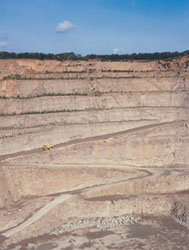Accurate predictions of rock fragmentation after blasting
In Europe, aggregate and mining processes produce around 1.35 billion tons of blasted rock annually, out of which, 20% consists of material ranging between 10mm-20mm. This fine material cannot be efficiently further processed and therefore, it is normally dumped posing increased requirements for suitable land spaces. Furthermore, this wasted material is not very stable and may potentially become hazardous for public safety and the environment. In an effort to reduce the amount of the unusable aggregate and mining products, the LESS_FINES project focused on a better control strategy of the blasting process. The project work involved not only adaptation of the explosives, but also of the timing procedure as well, according to the natural breakage characteristics of the rock. Therefore, the natural breakage characteristic of the rock mass was characterised and the actual blast fragmentation currently found in quarries was measured. More specifically, researchers explored the capabilities of the Swebrec function that best describes fragment size distribution from rock breakage and fragmentation after blasting and crushing. This three-parameter function was found to be in good correlation with data collected over a range of fragment sizes of 2-3 orders of magnitude. An improved five-parameter version was found to better reproduce sieved fragmentation curves even for materials within the 100-micron range and also describes ball mill grinding data. By combining the Swebrec function with suitable models, such as the extended Kuz-Ram model, researchers have a powerful tool to employ for studying rock fragmentation. This is mainly due to the fact that the Swebrec function increases the predictive power of the Kuz-Ram model particularly in the finer ranges. The tool can be applied in the forecast of any deviations of the fragmentation result from the natural breakage characteristic curve of the rock mass.



